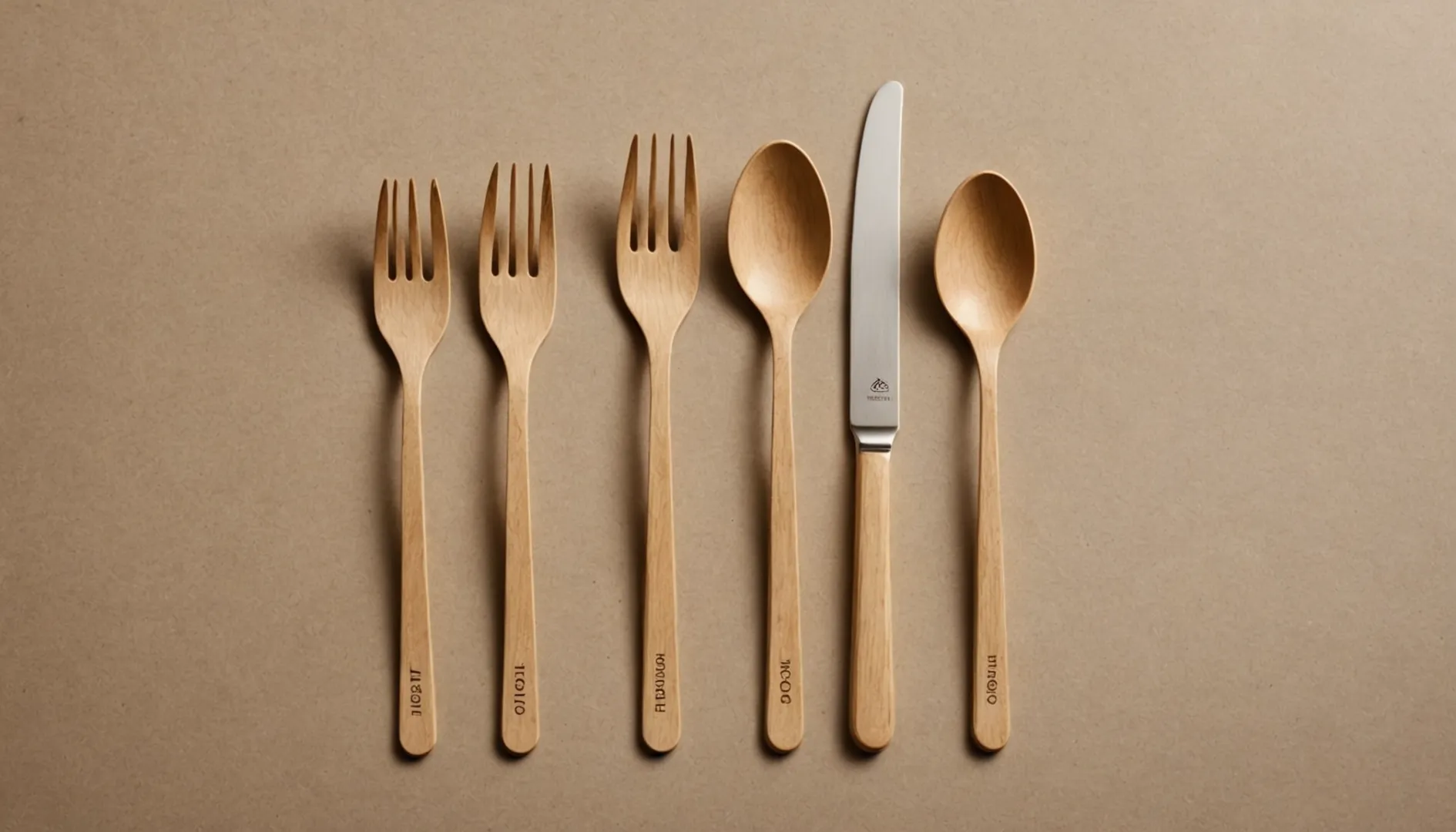
Ever found yourself in the dilemma of choosing between wooden or bagasse cutlery for your party?
When comparing disposable wooden and bagasse cutlery, both are compostable and eco-friendly. Wooden cutlery is made from birch or poplar wood and is sturdy, suitable for hot foods. Bagasse cutlery, made from sugarcane fiber, decomposes faster but isn't ideal for very hot items. Each has unique benefits depending on your needs.
I remember planning my sister's outdoor wedding and fretting over the smallest details—like the cutlery! I wanted to keep it eco-friendly, but the choice wasn't straightforward. If you’re like me, wanting to balance practicality with sustainability, understanding these options can be a game-changer. Wooden cutlery offers sturdiness, perfect for those hearty meals; meanwhile, bagasse cutlery, though not as heat-resistant, won my heart for its quick decomposition time. Depending on the nature of your event and your personal values, both choices have their perks.
Wooden cutlery decomposes faster than bagasse cutlery.False
Bagasse cutlery decomposes in 60-90 days, quicker than wooden cutlery.
Bagasse cutlery is more heat-resistant than wooden cutlery.False
Wooden cutlery is suitable for hot foods, unlike bagasse.
What Materials Are Used in Wooden and Bagasse Cutlery?
Ever wondered what makes your cutlery eco-friendly? Dive into the world of wooden and bagasse cutlery to find out how their materials make a big difference.
Wooden cutlery is crafted from natural birch or poplar wood, while bagasse cutlery is made from sugarcane fiber, a by-product of sugar production. Both materials are fully compostable, offering environmentally friendly alternatives to traditional plastic cutlery.
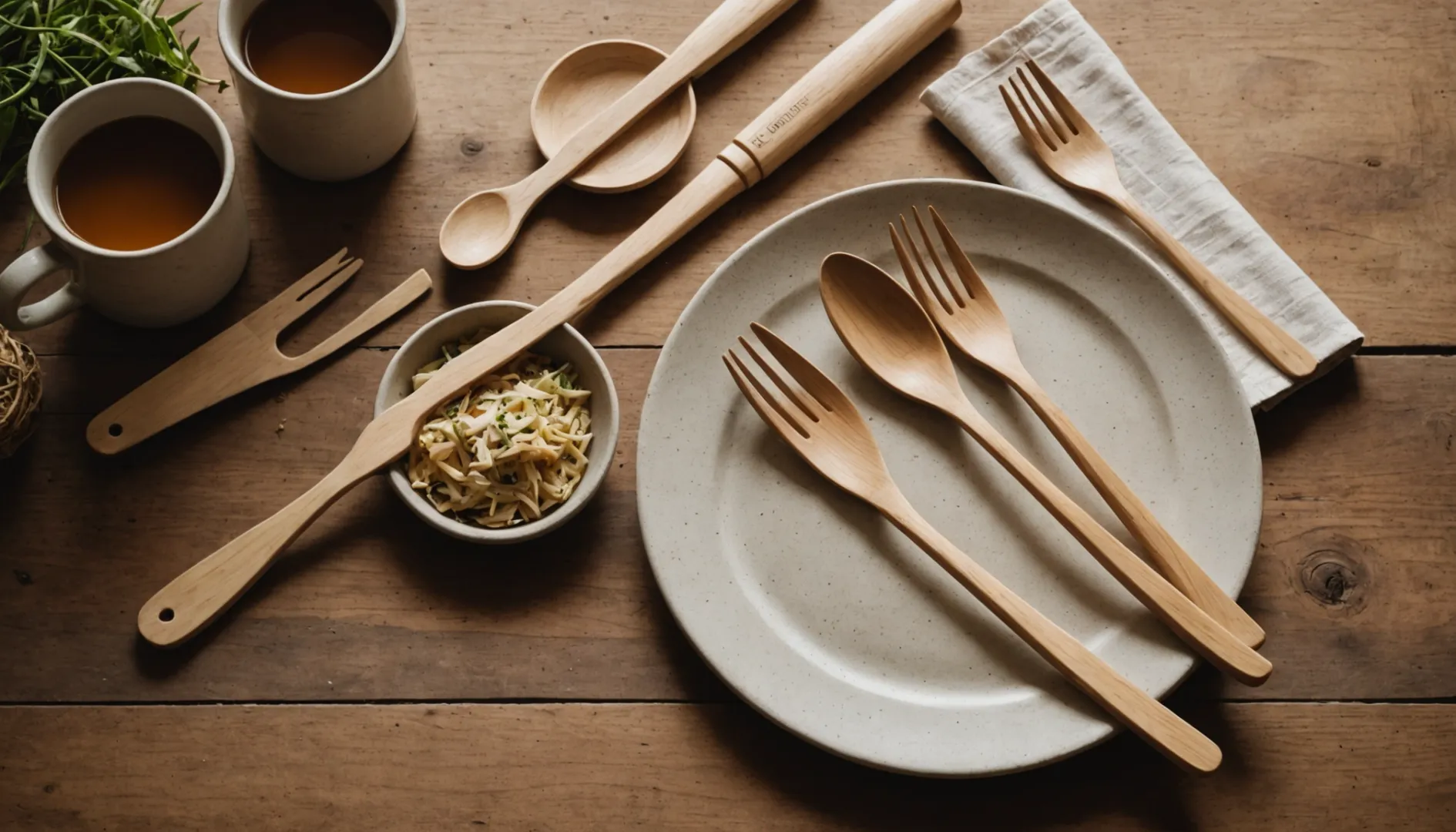
Understanding Wooden Cutlery Materials
When I first started exploring eco-friendly dining options, wooden cutlery caught my eye. Imagine this: you're at a picnic, and instead of reaching for flimsy plastic forks, you grab sturdy utensils made from birch or poplar wood. These woods aren't just picked at random; they're chosen because they don't easily splinter and are wonderfully lightweight. Plus, they're abundant in nature, so using them doesn't wreak havoc on the environment.
I remember the first time I used wooden cutlery at a family gathering. It was a small change, but knowing that the utensils were compostable and free from chemicals made me feel like I was doing my bit for the planet. If you're curious about diving deeper into the sustainability of wooden materials1, it's fascinating to see how such simple choices can make a difference.
Delving into Bagasse Cutlery Composition
Bagasse was a new term for me until I stumbled upon it in my quest for green alternatives. Picture the sugarcane fields where, after extracting sugar, there's leftover fibrous material. Instead of letting it go to waste, this by-product is transformed into durable cutlery. Isn't that amazing?
I tried bagasse cutlery at a friend's eco-themed wedding. It felt good to know that these utensils would decompose in just 60-90 days. It’s like giving Mother Nature a helping hand without compromising on quality or design. The whole experience made me appreciate how products like these can be molded into various shapes while staying kind to our environment. For more insight into bagasse production2 and its benefits, it's worth exploring.
Comparing the Eco-Friendliness of Both Materials
Choosing between wooden and bagasse cutlery can be a bit like picking between two equally great friends. Wooden cutlery's sturdiness makes it perfect for those hot dishes I love serving during family dinners. But when I need something that breaks down quickly, especially when organizing events, bagasse wins hands down.
Ultimately, both options cater to different needs but share the same eco-friendly mission. It all boils down to what aligns best with your sustainability goals. Whether it's reducing landfill waste rapidly or enjoying a hot meal with reliable utensils, understanding these differences lets us make informed choices. If you're keen on the environmental impact of disposable cutlery3, seeing how each material fits into waste management strategies can be quite eye-opening.
Wooden cutlery is made from sugarcane fiber.False
Wooden cutlery is made from natural birch or poplar wood.
Bagasse cutlery decomposes faster than wooden cutlery.True
Bagasse cutlery decomposes in 60-90 days, faster than wood.
How Do Wooden and Bagasse Cutlery Compare in Compostability?
Ever wondered which eco-friendly cutlery option is better for our planet? Let me share what I discovered about wooden and bagasse cutlery's compostability!
Wooden and bagasse cutlery are both compostable, but bagasse has the edge with a faster decomposition time of 60-90 days. Wooden cutlery is biodegradable but may decompose slower depending on environmental factors. Both are sustainable alternatives to plastic.
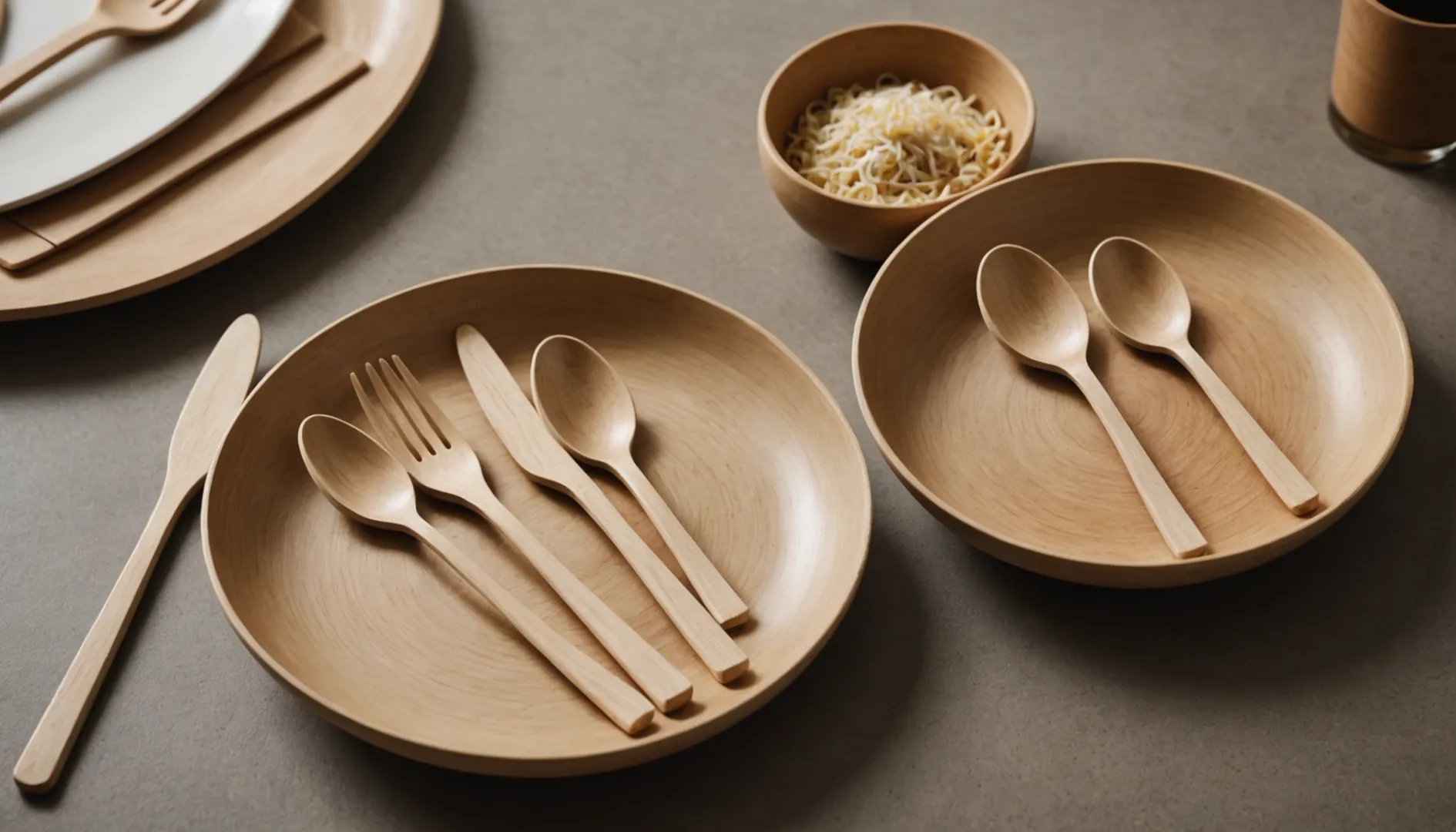
Understanding Compostability of Wooden Cutlery
I remember the first time I held a piece of wooden cutlery—it was at a cozy outdoor picnic. The feel of the natural wood between my fingers instantly connected me to nature. Wooden cutlery, often made from birch or poplar, is naturally biodegradable. But here's the thing: while it does break down over time, it might take longer than you'd expect, depending on factors like moisture and microbial activity. Once, I noticed a wooden fork starting to splinter after just a couple of uses—not a huge deal for composting, but something to keep in mind if you're serving hot foods.
Wooden cutlery remains a popular choice due to its sturdy nature and ability to handle hot foods effectively. For those interested in how wooden cutlery performs4 in various environments, it's worth considering these aspects when making your choice.
Exploring Bagasse Cutlery Compostability
Switching gears to bagasse cutlery—I first encountered it at a friend's eco-friendly wedding. Made from sugarcane fiber, bagasse is an exciting choice because it decomposes quickly, usually within 60-90 days under optimal conditions. This speed is a game-changer if you're keen on reducing waste fast.
Bagasse's heat resistance is another plus, though it's not as suitable for extremely hot items compared to wood. The material's sturdiness and resistance to bending make it comparable to wood in terms of durability. For those interested in how bagasse performs5 in various composting environments, it provides a fascinating case study of effective waste management.
Key Considerations for Eco-Friendly Dining
So, when deciding between wooden and bagasse cutlery, think about what's most important to you: do you want something that decomposes quickly, or do you value durability and heat resistance more? Both options are fantastic eco-friendly alternatives to plastic.
As more people shift towards sustainable dining practices, understanding the lifecycle and impact of these materials becomes crucial. Dive deeper into sustainable practices6 to make informed choices that match your environmental values.
Wooden cutlery decomposes faster than bagasse.False
Bagasse cutlery decomposes in 60-90 days, quicker than wooden cutlery.
Bagasse cutlery is microwave-safe but not for very hot items.True
Bagasse is suitable for microwaving, but not ideal for very hot foods.
Is Wooden Cutlery More Durable Than Bagasse?
Ever pondered whether wooden or bagasse cutlery holds up better in real life? Let's dive into this eco-friendly face-off.
Wooden cutlery typically outlasts bagasse in terms of durability. It's tough, can handle heat, and doesn't break easily. However, bagasse cutlery, while less durable, is great for composting, breaking down in about 60-90 days.
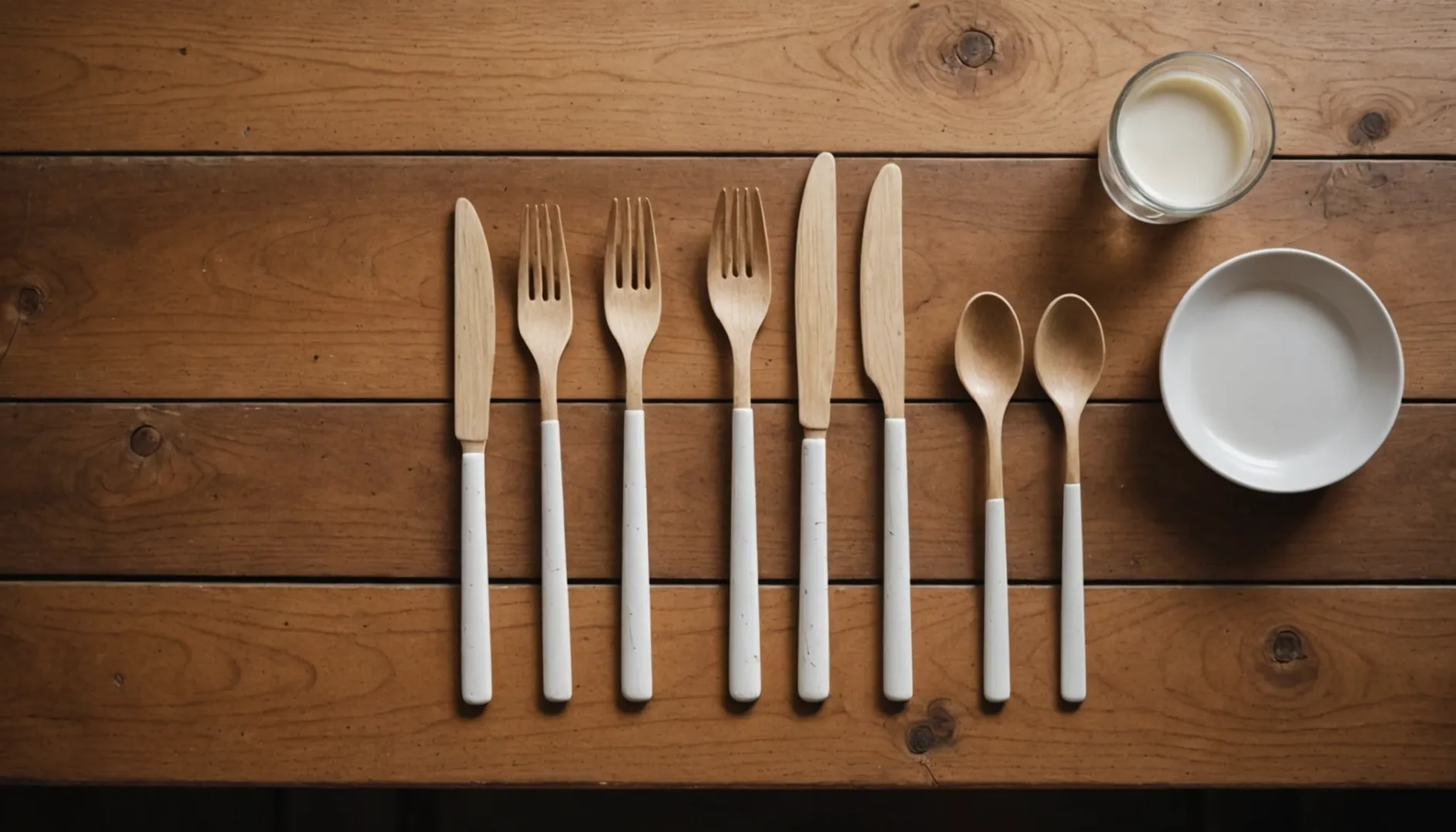
Material Composition and Structure
I remember the first time I hosted a picnic using eco-friendly options; I opted for wooden cutlery, crafted from natural birch or poplar wood. Its robustness and the feel of the grain between my fingers were reassuring. The wood's grain structure gives it inherent strength, making it less likely to bend or snap under pressure—perfect for when you need that extra oomph to cut through something substantial.
In contrast, bagasse cutlery—made from sugarcane fiber—is like the underdog that surprises you with its dense fiber composition. It’s sturdy but flexible, which means it might bend if you’re putting a lot of force behind it. Think of it as that friend who’s dependable for the easy-going tasks.
Heat Resistance Considerations
Here's a little nugget from my personal experience: handling hot foods is where wooden cutlery shines. Picture this—I was serving hot soup at a gathering, and I noticed how well the wooden cutlery performed without any deforming drama. Bagasse, although microwave-safe, tends to soften with very hot items, so it might not be your go-to for piping hot dishes.
Environmental Impact and Decomposition
Both options score big points in the eco-friendly department. I once organized an event where rapid waste decomposition was a priority, and bagasse7 was a star player. It breaks down in about 60-90 days—ideal for minimizing environmental impact quickly. Wooden cutlery takes a bit longer to decompose but maintains its strength throughout use, offering a reliable option that still respects Mother Earth.
Practical Usability in Everyday Scenarios
In everyday dining adventures, your choice might depend on what you're aiming for. I’ve found wooden cutlery to be my trusty sidekick for meals that require a firm grip and cutting prowess. Meanwhile, bagasse8 shines at large events where you want disposal ease and fast decomposition to take center stage.
Ultimately, getting to know the ins and outs of each material helps in making an informed decision. Both have their strengths, and the right choice hinges on your specific needs—whether it’s durability or environmental considerations leading the charge.
Wooden cutlery is more heat-resistant than bagasse.True
Wooden cutlery is suitable for hot foods, unlike bagasse.
Bagasse cutlery decomposes faster than wooden cutlery.True
Bagasse cutlery decomposes in 60-90 days, faster than wood.
What Are the Best Uses for Each Type of Cutlery?
Ever wonder why there's a different fork for every dish or why a spoon just feels right for soup?
The best use for each type of cutlery depends on what you're eating or drinking. Forks work wonders with meats and pasta, knives are your go-to for slicing and spreading, while spoons handle soups and desserts beautifully. Materials like stainless steel or eco-friendly options vary in durability and heat resistance.
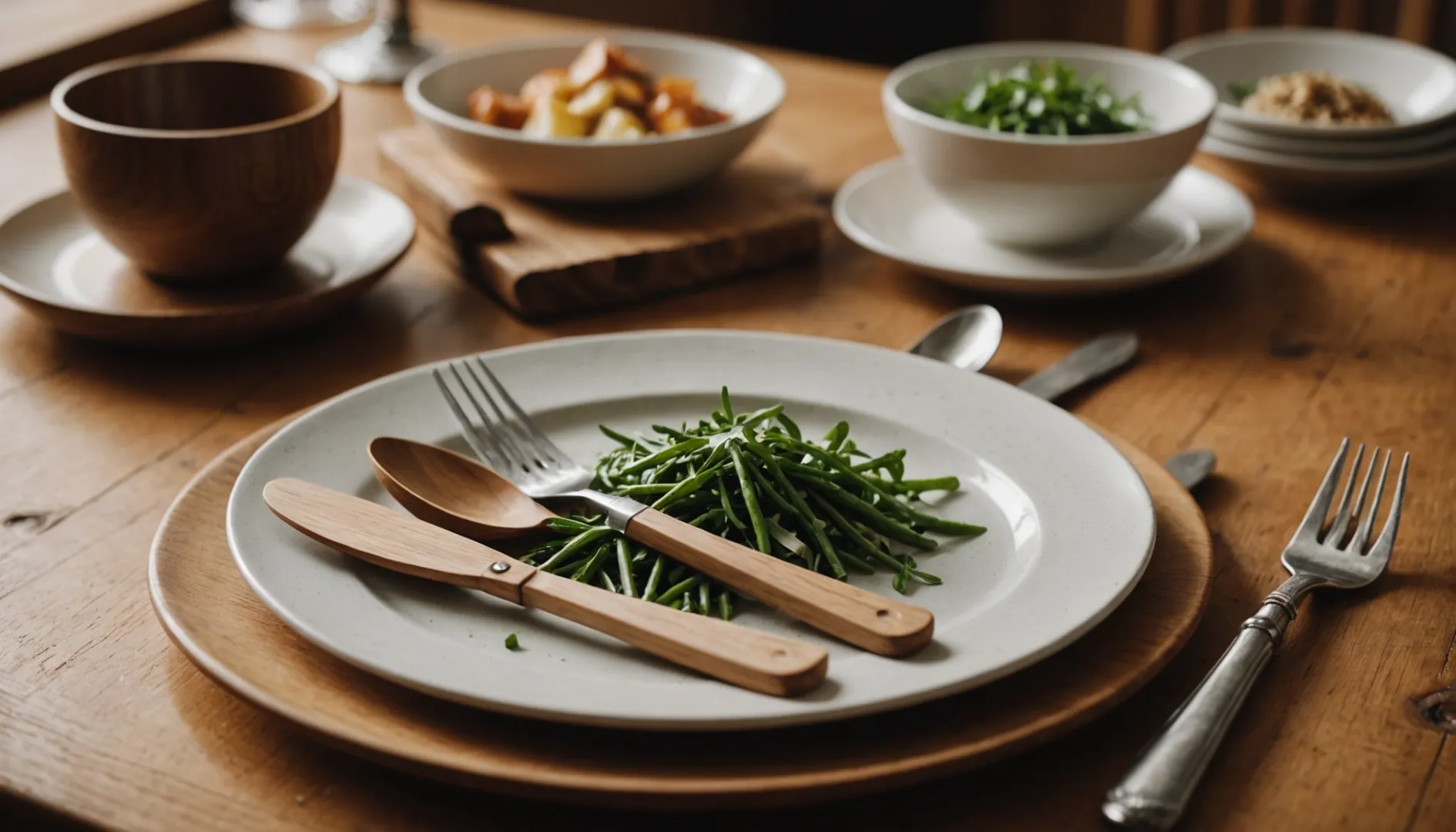
Forks: Versatile Tools for Solid Foods
I remember my first formal dinner. I stared at the multiple forks beside my plate, wondering if anyone noticed my confusion. Turns out, forks are essential for meals with solid foods like meats, pasta, and salads. The dinner fork is your main course hero, while smaller ones tackle salads or desserts. Ever tried using a salad fork9 with its wider tines? It’s perfect for leafy greens and veggies, making dining etiquette feel less intimidating.
Knives: For Cutting and Spreading
Knives are like the unsung heroes of the kitchen. They're all about cutting through meats or spreading your favorite jams. I once sliced through a tough steak with a steak knife10 that had a serrated edge—what a difference! Butter knives, with their soft touch, are just right for spreading butter or cheese. And those paring knives? Lifesavers when you’re peeling apples or dicing veggies for that homemade pie.
Spoons: Ideal for Liquids and Soft Foods
Picture this: a steaming bowl of soup on a chilly day, and your spoon sinking perfectly into it. Spoons are made for liquids like soups, and soft treats like ice cream. A soup spoon11 with its deeper bowl can hold more broth, while dessert spoons are daintier for sweets. Teaspoons? Perfect for stirring your morning coffee or measuring ingredients when baking.
Eco-Friendly Alternatives: Wooden and Bagasse Cutlery
With our planet in mind, I've started exploring eco-friendly options like wooden or bagasse cutlery. Wooden cutlery is sturdy but can sometimes splinter—reminds me of that one picnic where I ended up with a splinter! Bagasse, made from sugarcane fibers, is compostable and great if you’re eco-conscious, although not ideal for very hot meals. Both choices are compostable and wonderful for sustainable dining.
Choosing the right cutlery can really transform your dining experience. Whether you're after longevity or want to be kind to the environment, knowing which utensil suits each dish can make all the difference. Exploring different cutlery styles12 can help you make choices that fit your lifestyle and dining needs.
Wooden cutlery is fully compostable.True
Wooden cutlery is made from natural materials and decomposes naturally.
Bagasse cutlery is not suitable for hot foods.False
Bagasse cutlery is microwave-safe and can handle hot foods.
Conclusion
Wooden and bagasse cutlery are eco-friendly options, with wooden being sturdy for hot foods and bagasse decomposing faster. Both are compostable, catering to different sustainability needs.
-
Discover how renewable wood contributes to sustainable practices. ↩
-
Understand the eco-friendly process behind bagasse manufacturing. ↩
-
Learn about the role of cutlery materials in waste reduction. ↩
-
Learn why wooden cutlery is a natural biodegradable option. ↩
-
Discover how quickly bagasse cutlery decomposes and its benefits. ↩
-
Explore eco-friendly dining options to reduce environmental impact. ↩
-
Learn about bagasse's composition and how it influences durability. ↩
-
Discover bagasse's environmental impact and decomposition rate. ↩
-
Learn why salad forks have wider tines for better functionality. ↩
-
Understand features that enhance cutting efficiency in steak knives. ↩
-
Discover why soup spoons are designed with deeper bowls. ↩
-
Explore diverse cutlery designs to suit different dining occasions. ↩

